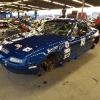Hey all,
I have a 1.6 I built into an ITA car. I need some help diagnosing an issue with the front brakes.
New calipers, rotors, pads (Hawk DTC-60/30) and stainless lines all around. I have only done one track day at Nelson and a wet weekend at MId-Ohio. I didn't notice anything at Nelson but during the practice day at MO, another driver (Frank Todaro) noticed a lot of sparking coming off the fronts. Everything looked ok when I pulled it apart and Frank said that the sparking seemed to have gone away after a few more sessions. I will say that the brakes felt inconsistent over the course of the weekend, but I couldn't pinpoint any issue.
My plan was to replace everything at each corner before going out again. When I pulled the rears, the calipers were as clean as the day I put them on and the pads and rotors showed very little wear if any. The fronts however show severe wear on both the pads and rotors. The pads are almost gone and both rotors have worn a mm deep or more on both sides. I was thinking a stuck caliper before I pulled them off, but both sides?
I need to try and diagnose the actual problem before putting all of this back together again, but I am not sure what to dig into. I have verified that the pads are the correct part number and I got the rotors direct from Mazda. I have attached pics of the caliper, pads and rotors from the left front. What do I need to look at before installing all the new stuff?
Thanks for the help.
 IMG_1374.jpg 75.67KB
2 downloads
IMG_1374.jpg 75.67KB
2 downloads
 IMG_1375.jpg 86.47KB
0 downloads
IMG_1375.jpg 86.47KB
0 downloads
 IMG_1376.jpg 86.2KB
0 downloads
IMG_1376.jpg 86.2KB
0 downloads
 IMG_1377.jpg 95.98KB
0 downloads
IMG_1377.jpg 95.98KB
0 downloads
 IMG_1379.jpg 52.53KB
0 downloads
IMG_1379.jpg 52.53KB
0 downloads
 IMG_1380.jpg 68.56KB
0 downloads
IMG_1380.jpg 68.56KB
0 downloads




 Sign In
Sign In Create Account
Create Account





 Back to top
Back to top Report
Report









